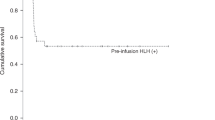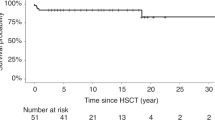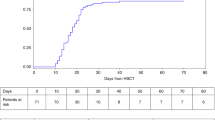Abstract
Hurler syndrome (HS) is an autosomal recessive, inherited metabolic storage disorder due to deficiency of lysosomal alpha-L-iduronidase (IDU) enzyme activity. Untreated patients develop progressive mental retardation and multisystem morbidity with a median life expectancy of 5 years. Allogeneic hematopoietic cell transplantation (HCT) can achieve stabilization and even improvement of intellect, with long-term survival. However, children with HS have an increased incidence of graft failure, usually with concomitant autologous marrow reconstitution. Between 1983 and 2000, 71 Hurler children underwent HCT at the University of Minnesota. Of these 71, 19 (27%) experienced graft failure. We report HCT outcomes in all 11 Hurler patients receiving a second HCT at the University of Minnesota. Median age at second HCT was 25 months (range, 16 to 45 months); median time from first HCT was 8 months (range, 4 to 18.5 months). The conditioning regimen consisted of cyclophosphamide/TBI/ATG (n = 8) or busulfan/cyclophosphamide/ATG (n = 3). The source of bone marrow was an unrelated donor in six, matched sibling in four, and mismatched related in one. Five of the 11 grafts were T cell depleted prior to infusion. Overall, 10 of 11 patients showed donor-derived engraftment, of whom three developed grade 3 to 4 acute GVHD. Five of 11 patients are surviving a median of 25 months (range, 2 months to 12 years) with an overall actuarial survival of 50% (95% CI, 27% to 93%) at 4 years. All five show sustained donor engraftment with normalization of IDU activity levels. Three of five evaluable patients demonstrated stabilization of neuropsychological function after second HCT. Currently, allogeneic donor-derived hematopoiesis provides the only chance for long-term survival and improved quality of life in Hurler patients. While graft failure in Hurler patients requires further investigation, a timely second HCT can be well-tolerated and beneficial.
Bone Marrow Transplantation (2002) 29, 491–496. doi:10.1038/sj.bmt.1703395
This is a preview of subscription content, access via your institution
Access options
Subscribe to this journal
Receive 12 print issues and online access
$259.00 per year
only $21.58 per issue
Buy this article
- Purchase on Springer Link
- Instant access to full article PDF
Prices may be subject to local taxes which are calculated during checkout

Similar content being viewed by others
References
Neufeld EF, Muenzer J . The mucopolysaccharidoses. In: Scriver C, Beaudet A, Sly W, Valle D (eds) The Metabolic and Molecular Bases of Inherited Diseases, 7th edn McGraw-Hill: New York 1995 2465 2494
Cleary MA, Wraith JE . The presenting features of mucopolysaccharidosis type IH (Hurler syndrome) Acta Paediatr 1995 84: 337 339
Masterson EL, Murphy PG, O'Meara A et al. Hip dysplasia in Hurler's syndrome: orthopaedic management after bone marrow transplantation (see comments) J Pediatr Orthop 1996 16: 731 733
Tandon V, Williamson JB, Cowie RA, Wraith JE . Spinal problems in mucopolysaccharidosis I (Hurler syndrome) J Bone Joint Surg Br 1996 78: 938 944
Gullingsrud EO, Krivit W, Summers CG . Ocular abnormalities in the mucopolysaccharidoses after bone marrow transplantation. Longer follow-up Ophthalmology 1998 105: 1099 1105
Braunlin EA, Krivit W, Burke BA et al. Radiological case of the month. Coarctation of the aorta in Hurler syndrome Arch Pediatr Adolesc Med 2000 154: 841 842
Krivit W, Henslee-Downey J, Klemperer MR et al. Survival in Hurler's disease following bone marrow transplantation in 84 patients Bone Marrow Transplant 1995 15: S182
Guffon N, Souillet G, Maire I et al. Follow-up of nine patients with Hurler syndrome after bone marrow transplantation (see comments) J Pediatr 1998 133: 119 125
Kakkis ED, Muenzer J, Tiller GE et al. Enzyme-replacement therapy in mucopolysaccharidosis I New Engl J Med 2001 344: 182 188
Peters C, Balthazor M, Shapiro EG et al. Outcome of unrelated donor bone marrow transplantation in 40 children with Hurler syndrome Blood 1996 87: 4894 4902
Peters C, Shapiro EG, Krivit W . Neuropsychological development in children with Hurler syndrome following hematopoietic stem cell transplantation (editorial; comment) Pediatr Transplant 1998 2: 250 253
Peters C, Shapiro EG, Anderson J et al. Hurler syndrome: II. Outcome of HLA-genotypically identical sibling and HLA-haploidentical related donor bone marrow transplantation in fifty-four children. The Storage Disease Collaborative Study Group Blood 1998 91: 2601 2608
Shapiro EG, Lockman LA, Balthazor M, Krivit W . Neuropsychological outcomes of several storage diseases with and without bone marrow transplantation J Inherit Metab Dis 1995 18: 413 429
Whitley CB, Ramsay NK, Kersey JH, Krivit W . Bone marrow transplantation for Hurler syndrome: assessment of metabolic correction Birth Defects Original Article Series 1986 22: 7 24
Krivit W, Sung JH, Shapiro EG, Lockman LA . Microglia: the effector cell for reconstitution of the central nervous system following bone marrow transplantation for lysosomal and peroxisomal storage diseases Cell Transplant 1995 4: 385 392
Whitley CB, Belani KG, Chang PN et al. Long-term outcome of Hurler syndrome following bone marrow transplantation Am J Med Genet 1993 46: 209 218
Phipps S, Mulhern R . Developmental outcome of unrelated donor bone marrow transplantation in children with Hurler syndrome (letter) Blood 1997 89: 732 734
Malone BN, Whitley CB, Duvall AJ et al. Resolution of obstructive sleep apnea in Hurler syndrome after bone marrow transplantation Int J Pediatr Otorhinolaryngol 1988 15: 23 31
Braunlin EA, Hunter DW, Krivit W et al. Evaluation of coronary artery disease in the Hurler syndrome by angiography Am J Cardiol 1992 69: 1487 1489
Peters C, Shapiro EG, Krivit W . Hurler syndrome: past, present, and future (editorial; comment) J Pediatr 1998 133: 7 9
Vellodi A, Young EP, Cooper A et al. Bone Marrow transplantation for mucopolysaccharidosis type I: experience of two British centres Arch Dis Child 1997 76: 92 99
Hoogerbrugge PM, Brouwer OF, Bordigoni P et al. Allogeneic bone marrow transplantation for lysosomal storage diseases Lancet 1995 345: 1398 1402
Champlin RE, Coppo P, Howe C . National marrow donor program: progress and challenges Bone Marrow Transplant 1993 11: (Suppl. 1) 41 44
Traycoff CM, Broun ER, Burgess J et al. Evaluation of the hematopoietic potential of CD34-enriched autologous bone marrow grafts prepared with the Baxter Isolex 300 Exp Hematol 1994 22: 554a
Glucksberg H, Storb R, Fefer A et al. Clinical manifestations of graft-versus-host disease in human recipients of marrow from HL-A-matched sibling donors Transplantation 1974 18: 295 304
Kaplan E, Meier P . Nonparametric estimation from incomplete observations J Am Stat Assoc 1958 53: 457 481
Atkinson K, Biggs J, Concannon A et al. Second marrow transplants for recurrence of haematological malignancy Bone Marrow Transplant 1986 1: 159 166
Wagner JE, Santos GW, Burns WH, Saral R . Second bone marrow transplantation after leukemia relapse in 11 patients Bone Marrow Transplant 1989 4: 115 118
Mrsic M, Horowitz MM, Atkinson K et al. Second HLA-identical sibling transplants for leukemia recurrence Bone Marrow Transplant 1992 9: 269 275
Radich JP, Sanders JE, Buckner CD et al. Second allogeneic marrow transplantation for patients with recurrent leukemia after initial transplant with total-body irradiation-containing regimens J Clin Oncol 1993 11: 304 313
Bosi A, Bacci S, Miniero R et al. Second allogeneic bone marrow transplantation in acute leukemia: a multicenter study from the Gruppo Italiano Trapianto Di Midollo Osseo (GITMO) Leukemia 1997 11: 420 424
McCann SR, Bacigalupo A, Gluckman E et al. Graft rejection and second bone marrow transplants for acquired aplastic anaemia: a report from the Aplastic Anaemia Working Party of the European Bone Marrow Transplant Group Bone Marrow Transplant 1994 13: 233 237
Storb R, Weiden PL, Sullivan KM et al. Second marrow transplants in patients with aplastic anemia rejecting the first graft: use of a conditioning regimen including cyclophosphamide and antithymocyte globulin Blood 1987 70: 116 121
Grandage VL, Cornish JM, Pamphilon JH et al. Second allogeneic marrow transplants from unrelated donors for graft failure following initial unrelated donor bone marrow transplantation Bone Marrow Transplant 1998 21: 687 690
Champlin RE, Horowitz MM, van Bekkum DW et al. Graft failure following bone marrow transplantation for aplastic anemia: risk factors and treatment results Blood 1989 73: 606 613
Belani KG, Krivit W, Carpenter BL et al. Children with mucopolysaccharidosis: perioperative care, morbidity, mortality, and new findings J Pediatr Surg 1993 28: 403 408 discussion 408 410
King DH, Jones RM, Barnett MB . Anaesthetic considerations in the mucopolysaccharidoses Anaesthesia 1984 39: 126 131
Woolley MM, Morgan S, Hays DM . Heritable disorders of connective tissue. Surgical and anesthetic problems J Pediatr Surg 1967 2: 325 331
Vassal G, Fischer A, Chalhne D et al. Busulfan disposition below the age of three: alteration in children with lysosomal storage disease Blood 1993 82: 1030 1034
Jacobson P, Park JJ, DeFor TE et al. Oral busulfan pharmakokinetics and engraftment in children with Hurler syndrome and other inherited metabolic storage diseases undergoing hematopoietic cell transplantation Bone Marrow Transplant 2001 27: 855 861
Acknowledgements
The authors acknowledge Dr Kumar Belani for his critical review of the manuscript. We also wish to thank our nurses in the unit and clinic for their tireless and excellent care of these challenging patients. This work was supported in part by the Children's Cancer Research Fund (CP) and by the National Institutes of Health NS29099 (WK).
Author information
Authors and Affiliations
Rights and permissions
About this article
Cite this article
Grewal, S., Krivit, W., Defor, T. et al. Outcome of second hematopoietic cell transplantation in Hurler syndrome. Bone Marrow Transplant 29, 491–496 (2002). https://doi.org/10.1038/sj.bmt.1703395
Received:
Accepted:
Published:
Issue Date:
DOI: https://doi.org/10.1038/sj.bmt.1703395
Keywords
This article is cited by
-
Non-myeloablative conditioning for second hematopoietic cell transplantation for graft failure in patients with non-malignant disorders: a prospective study and review of the literature
Bone Marrow Transplantation (2017)
-
Scheie syndrome: Enzyme replacement therapy does not prevent progression of cervical myelopathy due to spinal cord compression
Journal of Inherited Metabolic Disease (2009)
-
Combination of enzyme replacement and hematopoietic stem cell transplantation as therapy for Hurler syndrome
Bone Marrow Transplantation (2008)
-
Biochemical monitoring after haemopoietic stem cell transplant for Hurler syndrome (MPSIH): implications for functional outcome after transplant in metabolic disease
Bone Marrow Transplantation (2007)
-
Outcomes of hematopoietic stem cell transplantation for Hurler's syndrome in Europe: a risk factor analysis for graft failure
Bone Marrow Transplantation (2007)



